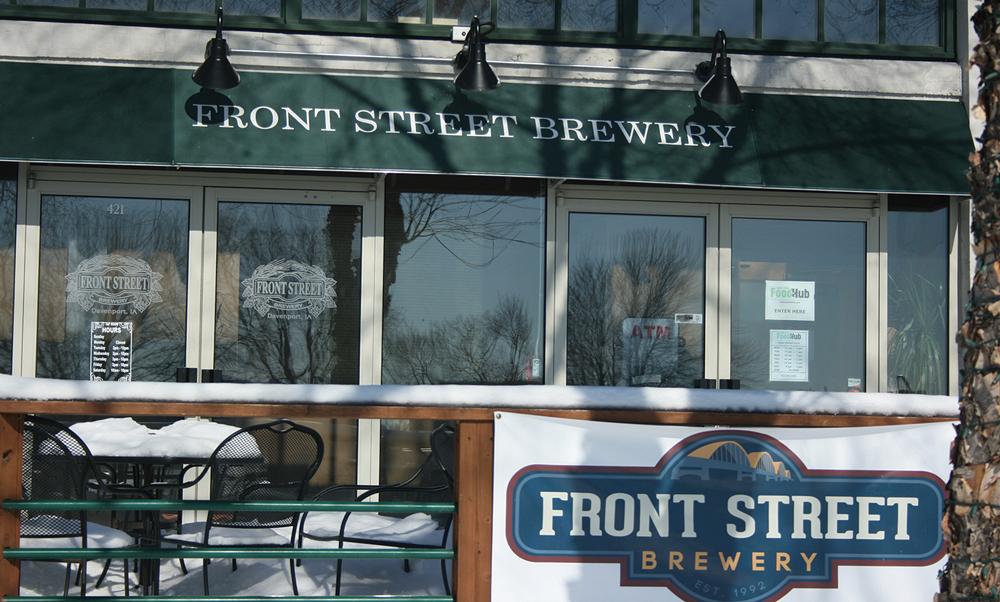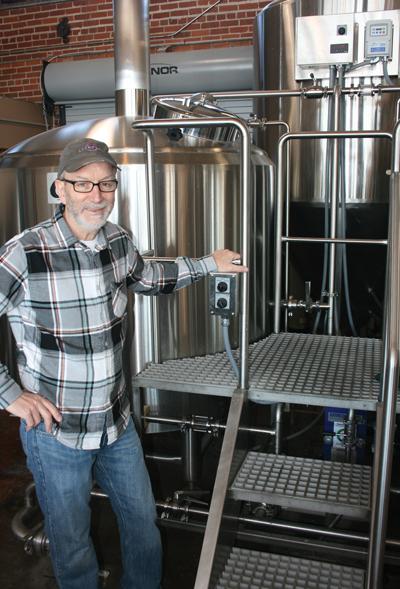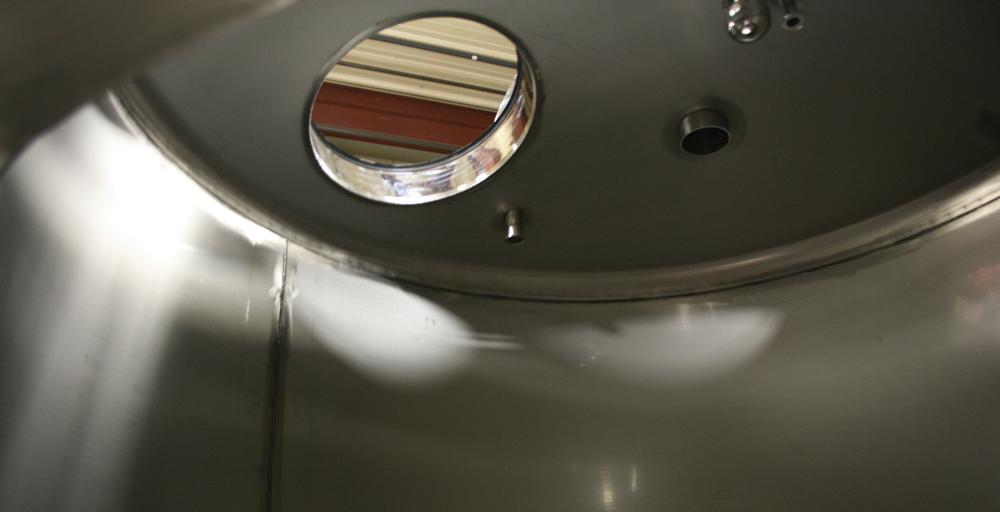- FMA
- The Fabricator
- FABTECH
- Canadian Metalworking
Categories
- Additive Manufacturing
- Aluminum Welding
- Arc Welding
- Assembly and Joining
- Automation and Robotics
- Bending and Forming
- Consumables
- Cutting and Weld Prep
- Electric Vehicles
- En Español
- Finishing
- Hydroforming
- Laser Cutting
- Laser Welding
- Machining
- Manufacturing Software
- Materials Handling
- Metals/Materials
- Oxyfuel Cutting
- Plasma Cutting
- Power Tools
- Punching and Other Holemaking
- Roll Forming
- Safety
- Sawing
- Shearing
- Shop Management
- Testing and Measuring
- Tube and Pipe Fabrication
- Tube and Pipe Production
- Waterjet Cutting
Industry Directory
Webcasts
Podcasts
FAB 40
Advertise
Subscribe
Account Login
Search
Make way for the brew crew
Fabricator and local brewer partnership becomes a recipe for success
- By Amanda Carlson
- May 5, 2014
- Article
- Arc Welding

In 2012 Zuidema purchased space to open the Front Street Brewery Tap Room, where he houses his new 15-barrel brew equipment. The Tap Room is within walking distance of the Front Street Brewery, which he runs with his wife.
If you’re a beer connoisseur with a palate that goes beyond the King in a Can, you’ve probably at least experimented with craft beer. Or maybe you’ve even tried brewing your own.
You and everyone else.
Craft beer production, according to an article published on CNBC.com, rose 9.6 percent in 2013, and the Brewers Association claims that breweries open at a rate of about 1.2 per day. It’s big business … competitive too. But new brewers are running into incredible lead-times for newly fabricated equipment. And if the long lead-times don’t frustrate them, it’s usually the equipment setup, troubleshooting, and brewing basics that do.
Longtime Davenport, Iowa, brewer Steve Zuidema has seen many a new brewer run into this dilemma. With more than 22 years’ experience in the brewing business, Zuidema knows plenty about the industry and current trends.
“We’re at the number of breweries that we were at before Prohibition. We’ve finally come full circle. Now, instead of having just three or four big players in the country, there’s maybe 2,500. People now are getting a palate and a taste for craft beer, because it’s also legitimate. When I first started up in the ’90s, there was some god-awful beer out there. Now the bar is so high for quality beer that if you don’t make a high-quality beer, you’re not even going to last,” Zuidema said.
Ahead of the Game
When Zuidema and his wife opened the Front Street Brewery on the edge of the Mississippi River in downtown Davenport in 1992, they had no idea they were 22 years ahead of a booming craft beer trend. But it’s worked out and the business is well-known regionally for being Iowa’s oldest craft brewery, which has been very good for business.
So good, in fact, that by 2011 it became impossible for Zuidema to make his beer fast enough.
“Over the last five years the brewing industry has picked up so much and sales have picked up so much. I found myself brewing constantly, and constantly running out of beer. So I knew I needed a bigger system,” Zuidema explained.
The problem was twofold. First, his current 7-barrel system, housed in Front Street’s cellar, was not big enough to keep up with demand. Second, installing larger-capacity brewing equipment was not possible in the current location because the confines of the space wouldn’t allow it. Luckily, the city of Davenport encouraged him to purchase space in a vacant freight house—an old industrial building—less than a mile from the original Front Street
Brewery, which is exactly what he did. Its intended use was to house the Front Street Tap Room, a complement to the existing brewery.

Brewer Steve Zuidema proudly stands next to the 15-barrel brew tank system that he designed for his Davenport, Iowa, Front Street Brewery. Crawford Co., Rock Island, Ill., brought his design to life in roughly six weeks and in the process discovered a new opportunity to diversify its business. (Photos courtesy of Amanda Carlson, associate editor.)
Same river view, same air of uniqueness, and within walking distance of the restaurant, but now there was space to brew more beer. All that was left was to find a fabricator to build his new brew equipment within a reasonable amount of time.Easier said than done.
“I looked around, and lead-times were terrible. I’ve always been a do-it-yourself person, and I thought this area—the Quad Cities—has been a manufacturing hot bed forever. We’ve got John Deere and Alcoa right in our backyard, and we’ve got some of the best welders that make some of the best equipment in the country. But we can’t build a brew tank here?” Zuidema exclaimed.
After a little bit of research, he made contact with Crawford Co., a jack-of-all-trades fabricator that specializes in plumbing, HVAC, air filtration equipment, and custom fabrication just a stone’s throw away in Rock Island, Ill. The company got its start in 1952 as a residential contractor for heating and air conditioning, explained Ian Frink, vice president. Growing steadily since then, the company added a weld shop and pursued more commercial heating and cooling work in the mid-1980s. In 2000 it purchased Monoxivent, a line of industrial air cleaning equipment.
Initially this was only supposed to be a one-time job like any other custom fabricating project. Zuidema, knowing exactly what he needed and didn’t need in a system, drew up a design and shared his vision with Crawford’s Keith Gerks, division manager of welding/laser sales; Frink; and Al Ehrecke, lead fabricator. Hoping to lower lead-times even further, Zuidema ordered as many parts as possible from U.S.-based manufacturers—many of which were local.
A shocking six weeks later, Crawford had completed Zuidema’s 15-barrel brew system, which included a polished stainless steel brew kettle, mash tun, platform, and process piping. The lining for the main kettle and mash tun had insulation and steam jackets, and the custom lower screen on the mash tun featured a removable lower screen with paddles and shaft.
“They had their lead-time ahead of what I wanted, and the stuff was basically sitting, waiting for my infrastructure to be finished. I wasn’t even ready for it yet. I was amazed it could be done that quickly. And absolutely no trouble with the system at all. It performed perfectly,” Zuidema said.What was incredibly astounding was the lightning-quick turnaround, especially since the average lead-time for a similar system was close to six months. And then it struck Zuidema: If Crawford could do this for him, why couldn’t they do this for umpteen other breweries that were popping up all over the country? And, furthermore, why couldn’t they use his design as a starting point? He knew the Crawford fabricators were fast, and he also knew that the components necessary to make a brew system could be found regionally.
“I got hold of Keith and said, ‘Do you think there’s something we can work out together? I think we could really make this pop.’ He spoke with Ian, and it was almost right away, virtually overnight, that we started doing something about it.”
From Crawford’s perspective, it was too good of an opportunity to pass up.
Slow, Steady, Smart Growth
In mid-2012, Crawford opened its brewing equipment division. The company reshuffled roughly six workers to charge the brewing division and hired Bob Keeney as drafter and three more welders. They also partnered with Zuidema to serve as consultant for new customers. After all, it was his design and his expertise in the brewing industry that made him an important piece of the puzzle.

After stainless steel sheets are cut and formed, they are joined with either gas tungsten arc welding (GTAW) or pulsed gas metal arc welding (GMAW-P).
With personnel in place, the next step was figuring out what niche the division was going to try to serve. Brew tanks come in a variety of sizes, so to keep things simple, they decided to offer Zuidema’s 15-barrel steam-fired system as standard. Even though they have gotten calls from potential customers requesting 7-, 10-, 20-, and 30-barrel systems, the company felt it best to slowly ramp up and grow the division the smart way.
“We’d have to build a whole division and hire 20 to 30 people to handle it. By just doing 15-barrel, we’re able to use the assets we already have here and grow this a little slower and figure out where our niche really is,” Zuidema explained.
Added Frink, “You get only one chance to come into a market and make a first impression. We don’t want to overpromise and underdeliver and get a bad reputation for having long lead-times. We have short lead-times right now and a quality product, and we want to grow in that direction.”
To help deliver on its promise for short lead-times, the company stocked enough components on the shelf to build a full system as soon as an order is placed, Keeney said. Parts and components are U.S.-made, if possible. The design itself, they feel, is also a perk because it is created by a brewer for a brewer. Design features are handy and ergonomically correct while maintaining a pleasing aesthetic.
Once a purchase order is received, the company begins procuring material. All tanks are fabricated with double-wall stainless steel.
Stainless steel sheets are laser cut and formed on either a press brake or roll formed.
“Anything that’s going to come in contact with the beer is TIG welded. But the outer surface of the inner shell, which is where the insulation is, we pulse MIG that because it’s hidden. It’s a faster process, but still a good weld. But any of the exterior welds are TIG welded. It’s all by hand,” Keeney said.
The weld is then acid cleaned and buffed with a little bit of hand polish. The acid cleaning process pairs an acid wash compound with electricity to remove heat tint on the weld bead. The system is then staged so that the company can install piping, which is also assembled with GTAW.
“We fit up all the pipes and we break them down into smaller pieces with just little clamps, and that way they’re labeled for what piece goes where so the installer doesn’t have to scratch his head as to how to put it back together,” Keeney added.
The whole process takes approximately two months.

All tanks are double-wall stainless steel. All components that come into contact with the beer are assembled using GTAW. The outer surface of the inner shell, which is where the insulation is located, is assembled with GMAW-P.
Exceeding Expectations
Reception has been positive in the two years since the creation of Crawford Brewing Equipment, but Frink noticed that the market is very different from the market for the company’s Monoxivent line, for example. As soon as the company began marketing its new capabilities, interest began pouring in. However, nobody pulled the trigger. In other words, they received a large quantity of leads but struggled finding the quality lead. Approximately 90 percent of those leads were from new breweries, he added, and so the hesitation was understandable.
“There’s some hesitation because, in their mind, we’re new. But we’re not new. We’re a 60-year-old company. The other thing is a lot of them are tire kickers, meaning they’re not sure they want to go into business to begin with,” Frink said.
Times are a little different now, however. Crawford Co. is seeing a lot of interest from start-ups in the Chicago area thanks to word-of-mouth advertising from customers in Crystal Lake, Tinley Park, and Lemont.
The partnership between Crawford Co. and Zuidema has only helped matters because it offers customers the luxury of having a built-in brewing expert at their disposal. Most times companies hire a brewing consultant separately to help choose equipment, navigate the brewing process, and answer questions. With Zuidema, not only are companies working with a guy that knows a lot about brewing beer, they’re also working with the guy who designed the brewing equipment and knows exactly how it works.
“I tell people, ‘You can hire a consultant in addition to working through us, or you can just work through me and feel that I’m your consultant, because I’m going to help you figure out what you want to do.’”
Keeney feels as though the brew tank division provides a competitive option for brewers in the states to get American-made equipment with a quick turnaround and personal customer service from order to install, which doesn’t usually happen when a company purchases equipment from overseas brew tank manufacturers.
“A lot of phone calls I get, the person on the other end is just happy to get someone who answers the phone or answers an e-mail within a couple of days,” Keeney explained.
So far 2014 has exceeded both Crawford’s and Zuidema’s expectations. Initially the company projected that it would complete and deliver five brew tank systems, but already the company has sold three and has several more in the works. Keeney said this year will be a good test to see if they can keep lead-times the same while balancing two or three projects at a time.
The excitement emanating from the group of people Zuidema affectionately refers to as “the brew crew” is palpable. And why shouldn’t it be? Everyone involved is getting more than they ever thought possible. For Zuidema, he’s having fun mentoring new breweries and sharing his wisdom and experience with those new to the business. He also gets to see his brain child design thrive and help new brewers fulfill their dream. Crawford is an example of the great things that can happen to companies that take calculated risks and recognize a unique opportunity to diversify when it is presented.
And as for the rest of us, we have the benefit of enjoying more and more delicious craft beer by the year.
About the Author

Amanda Carlson
2135 Point Blvd
Elgin, IL 60123
815-227-8260
Amanda Carlson was named as the editor for The WELDER in January 2017. She is responsible for coordinating and writing or editing all of the magazine’s editorial content. Before joining The WELDER, Amanda was a news editor for two years, coordinating and editing all product and industry news items for several publications and thefabricator.com.
About the Publication
subscribe now

The Welder, formerly known as Practical Welding Today, is a showcase of the real people who make the products we use and work with every day. This magazine has served the welding community in North America well for more than 20 years.
start your free subscription- Stay connected from anywhere

Easily access valuable industry resources now with full access to the digital edition of The Fabricator.

Easily access valuable industry resources now with full access to the digital edition of The Welder.

Easily access valuable industry resources now with full access to the digital edition of The Tube and Pipe Journal.
- Podcasting
- Podcast:
- The Fabricator Podcast
- Published:
- 04/16/2024
- Running Time:
- 63:29
In this episode of The Fabricator Podcast, Caleb Chamberlain, co-founder and CEO of OSH Cut, discusses his company’s...
- Trending Articles
Sheffield Forgemasters makes global leap in welding technology

ESAB unveils Texas facility renovation

Engine-driven welding machines include integrated air compressors

The impact of sine and square waves in aluminum AC welding, Part I

Compact weld camera monitors TIG, plasma processes

- Industry Events
16th Annual Safety Conference
- April 30 - May 1, 2024
- Elgin,
Pipe and Tube Conference
- May 21 - 22, 2024
- Omaha, NE
World-Class Roll Forming Workshop
- June 5 - 6, 2024
- Louisville, KY
Advanced Laser Application Workshop
- June 25 - 27, 2024
- Novi, MI



























